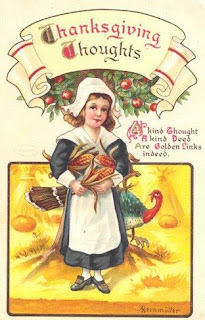This vintage Thanksgiving card has a typical cute Pilgrim girl wearing a long black dress with a big white collar, wide cuffs on her sleeves, and a white apron. For accessories, she has a huge white bonnet and clunky black shoes with big buckles. The stereotyped Pilgrim is immediately recognizable as a symbol of Thanksgiving. Unfortunately, the dress is almost certainly not anything a Pilgrim would have worn. The only historically accurate items in this photo are the apron and the cuffs on the sleeves.
In reality, a real Pilgrim girl from the 1620s would be more likely to wear almost any color besides black: purple, brown, red, green, yellow, or blue. The colors were probably muted, since the cloth was colored with vegetable based dyes. Even a wealthy girl who could afford the more expensive black cloth for a dress would only wear such an outfit on Sunday or for special occasions. Pilgrims had no religious objections to bright, fashionable clothing like the later puritans did, so many colors would have been worn. The later Puritans wore more sober clothing, and their fashions are perhaps what later artists (not worried about accuracy) used to create a "Pilgrim."
In Clara's more authentic Pilgrim dress, you may be able to recognize the Dutch influence in the style of clothing. Dutch styles and colors were popular in England at the time of the Pilgrim's journey to America. See if you can find similarities between the dress in this Frans Hals painting and Clara's Pilgrim dress.
In terms of actual fashion, a girl would have worn underclothing, a chemise (undershirt), a bodice or overdress, petticoats, a skirt, an apron, stockings, shoes, and a hat or bonnet. The bodice usually matched the skirt, and was sleeveless. It was worn over a chemise, which was usually a different color than the bodice. The stylishly narrow collar and long sleeves of the chemise were all that would show under the bodice. Wrist ruffs and turned-back cuffs were popular on sleeves for many, many years. Also, sometimes a ruff might be added to decorate the neckline.

Although Pilgrims are typically shown wearing huge buckles on their shoes, buckles were not fashionable or readily available. Buckles would not have been worn on shoes nor hats until the late 1600s. In the 1620s, shoes were tied with a ribbon or leather strips. Clara's shoes have round toes, low heels, cover most of her foot, and are tied neatly with a ribbon.
Clara has a tight-fitting bonnet – also called a coif or biggin – which she would wear daily to keep her hair clean. She may have worn a floppy felt hat in the same style as the men of the time. Women also commonly wore wide straw hats over their bonnets in the summer as they worked outdoors. However, the bonnet was the most common head covering at the time, although probably not with the huge wings most cartoon pilgrims wear.
To print Clara's outfit, use this PDF file:
 Clara's Dress 36
Clara's Dress 36 (717k)
Clara is a free, printable paper doll. Clara will continue to be available on this blog as long as I post new fashion pages for her. You can
read the introduction for the Clara paper doll here.
To print the Clara paper doll, use this PDF file:
 The Clara Paper Doll
The Clara Paper Doll (745k)


























